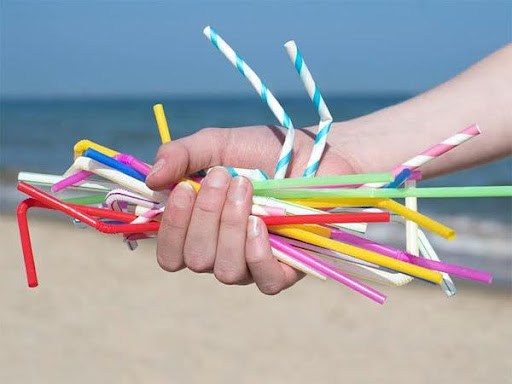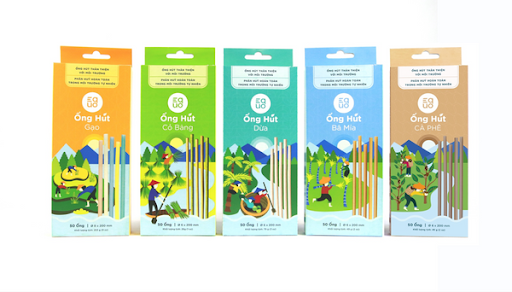To sign up for our daily email newsletter, CLICK HERE
Plastic straws have become an indispensable part of our daily lives. They are everywhere, from coffee shops and restaurants to large events and even family meals. They are not just tools for drinking but have also become a part of modern lifestyle, focusing on convenience and speed.
But are there any negative consequences hidden behind this convenience? Let’s explore plastic straws with EQUO, from their decomposability to their role in our daily lives and innovative alternative solutions.

1. What are plastic straws? History and role of plastic straws in modern life
Although straws have been around for a long time, plastic versions became popular in the mid-20th century when plastic manufacturing technology improved and costs decreased. The popularity of plastic straws grew significantly in the next decades, especially as single-use and takeaway consumption habits became prevalent.
Plastic straws are typically made from two main types of plastic: Polystyrene (PS) or Polypropylene (PP). Both of these plastics have ideal properties for straw production, such as flexibility, insulating ability, durability, and many more.
2. Pros of plastic straws
2.1. Cost-effective and simple production
One of the key reasons for the popularity of plastic straws is their cost-effectiveness and simple production process. Plastic is cheap and available, reducing the product’s overall cost. The manufacturing process is also straightforward, allowing for efficient mass production.
2.2. Exceptional durability
Plastic straws are not only cost-effective but also highly durable. They are resistant to damage and breakage and capable of withstanding pressure and relatively high temperatures. This makes them a suitable choice for a wide range of beverages, from water to hot or iced drinks.
2.3. Lightweight and convenient
The lightweight nature of plastic straws makes them convenient for easy carrying and storage. You can easily place them in your bag or even in your wallet, enabling you to use them anytime, anywhere.
2.4. Diverse styles
Another advantage of plastic straws is their diversity in terms of size, shape, and color. Plastic straws can serve various purposes, from decoration to specific drinking needs.

3. Cons – Hazards of plastic straws
Despite their advantages, plastic straws also have serious drawbacks. As a result, we are encouraged to evaluate the use of plastic straws in the broader context of environmental and public health concerns.
3.1. Slow decomposition and environmental impact
One of the major downsides of plastic straws is their slow decomposition rate. It can take up to two hundred years for them to decompose, causing significant environmental damage. They accumulate in landfills, rivers, and oceans, negatively affecting ecosystems and polluting the environment.
3.2. Impact on wildlife
When improperly disposed of, plastic straws can pose a serious danger to wildlife. Many animals, especially those living in aquatic environments, can ingest plastic straws, leading to health issues. Reports show that plastic straws have caused fatalities in species such as sea turtles, fish, and seabirds.

3.3. Effects on human health
Plastic straws affects not only the environment and animals but also the health of both producers and consumers. The additives in plastic can influence hormones and the immune system.
Polypropylene is another material found in plastic straws that can leach into drinks and release compounds that may affect estrogen levels, especially when exposed to heat, acidic beverages, or UV light.
4. What are plastic straws bans?
Plastic straws bans are measures implemented by many countries around the world to minimize the environmental impact of plastic waste. According to research, 91% of plastic waste is not recycled, and there are over 8.3 billion plastic straws floating on coastlines. Experts predict that by 2050, plastic waste will outnumber fish in the ocean.
These bans aim to raise awareness of the negative impact of plastic straws and contribute to the global goal of reducing plastic waste. Some countries that have implemented these bans include Canada, Argentina, the UK, the USA, Vietnam, Australia, and South Korea.

5. Alternative solutions to plastic straws
In the context of increasing environmental pollution from plastic straws, finding and implementing alternative solutions becomes more urgent than ever. Here are some notable solutions:
5.1. Environmentally friendly straw alternatives
- Grass straws: Made from natural grass, offering an eco-friendly option.
- Rice straws: Produced from 100% rice and tapioca starch, colored using natural vegetable and fruit juices, and biodegradable, ensuring safety.
- Coffee husk straws: Crafted from coffee husks, they are 100% plastic-free, home-compostable and have a relaxing aroma of coffee.
- Sugarcane fiber straws: Made from sugarcane fiber, with a mild, sweet aroma and biodegradable properties that won’t alter the taste of your beverage.
- Coconut straws: Manufactured from 100% fermented coconut water, they are highly flexible, do not dissolve in liquid.
All of these options are made from 100% plant-based materials and can fully compostable in the environment within 3-6 months. These straws not only protect the environment but also ensure consumer safety and are suitable for a wide range of beverages. EQUO is proud to provide all of these alternative solutions to replace traditional plastic straws, contributing to a cleaner environment.

5.2. Personal water bottles
Using personal water bottles not only reduces the use of plastic straws but also minimizes the consumption of plastic bottles. These bottles are designed for convenience, provide good insulation, and can be reused multiple times, saving money and protecting the environment.
5.3. Small habit changes
Small changes in daily habits can also contribute to reducing plastic straws usage. For example, refuse using plastic straws when ordering outdoor drinks, use your reusable straw, or drink directly from a cup. When each of us becomes aware of and implements these changes, we all contribute to a more sustainable future for the planet.
6. Creative ideas – How to recycle plastic straws
- Straw frame/art: Create artistic frames using hardback covers, colorful straws, a hot glue gun, and picture frames.
- Straw Christmas tree: Make a mini Christmas tree using cut-up straws glued to a base, and decorate with lights.
- Lampshade decor: Redesign lampshades by attaching colored straws to them.
- Pen holder: Use straws to encircle a cut-up plastic bottle or milk carton, creating a unique pen holder.
- Straw toy swing: Craft a toy swing set using straws and a cupcake mold.
- Spiral curtain tiebacks: Create decorative curtain tiebacks by wrapping spiraled straws around cords.
- Wind chime: Assemble straws in various lengths and attach them to a string for a homemade wind chime.
These ideas allow for creative recycling and repurposing of plastic straws, adding beauty and functionality to your living space.
Plastic straws have certain benefits, such as convenience and affordability, but they also bring many negative environmental and health impacts. Through this article, EQUO hopes that you will prioritize the use of environmentally friendly alternatives or make changes in your habits to minimize plastic straws usage. By doing so, we can protect the planet, and create a cleaner and more sustainable environment for future generations.